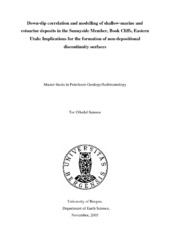| dc.description.abstract | The Sunnyside Member is part of the Blackhawk Formation and consists of shallow-marine and estuarine deposits reflecting high-frequency changes in sea level. Detailed mapping of the unit reveals an intra parasequence architecture which is comparable to that of similar successions in the Blackhawk Formation. However, the Sunnyside Member comprises a unique set of coarsening upward sandstone packages, termed bedsets, which are bounded by non-depositional discontinuity surfaces and which were deposited during normal coastal progradation, expressing a sub-horizontal shoreline trajectory. In a palaeolandward direction, these bedset boundaries pinch-out into the lower shoreface. The surfaces are characterized by a landward shift of facies and an abrupt decrease in sediment supply. Excellent 3D exposure in the study area allows careful down-dip correlation of the shallowmarine and estuarine units. The majority of successions are composed of interbedded mudstones and hummocky cross-stratified sandstones, representing a wave-dominated coastline; comprising uniform and basinward thickening wedges which can be traced for 5-10 km down-dip. However, one bedset demonstrates both wave and current-induced sedimentary structures in an overall basinward thinning wedge, indicating changes into a more mixed, fluvial and wave-influenced depositional environment, which has been interpreted to result from lateral migration of the river mouth. Previous investigations of intra parasequence discontinuity surfaces in the Blackhawk Formation have suggested that they may form in response to high-frequency changes in sea level, wave base or sediment supply. The results from modelling obtained in this study indicates that non-depositional discontinuity surfaces similar to the ones observed in the Sunnyside Member form during a combined low in both sediment supply and wave base. A comparison between these data and field observations suggests a connection between reorientation of the shoreline resulting from river mouth migration, and a relatively abrupt decrease in sediment supply and wave base. The bedsets in the study area are therefore interpreted to result from reconfiguration of the coastal morphology, sediment starvation, and localized relative deepening due to loading and compaction. This interpretation implies firstorder sand body connectivity both up depositional dip and along-strike between adjacent bedsets. Good understanding of the formation and pinch-out style of these units is of great importance in an exploration perspective as discontinuities will control fluid flow within a reservoir of parasequence scale. | en_US |
